Following my research for the previous article about the performance of SD/CF/USB flash modules, the only conclusion I could reach is that most of them are pretty dire. The only notable exception among the SD cards seems to be the latest generation of the SanDisk Extreme Pro (95MB/s) cards that just about managed to squeeze out enough performance on random writes to match a 7200rpm disk. Still, this is pretty dire compared to any reasonable SSD, so I wanted to see what else could be done about installing extra storage with good performance into an AC100.
What I came across is this: SuperTalent RC8 USB stick. It may look like a USB stick, but it is actually a full-on SSD, featuring a SandForce 1200 flash controller. I figured this was worth a shot, even though the4 specifications indicate it is rather large (far too large to fit inside an AC100 in it’s standard form). Stripped out of the casing, however, it looks like RC8 might just be fittable inside the AC100.
This is what I ended up with. There appears to be only one place inside an AC100 where a bare RC8 circuit board could be fitted. You will need the following:
1) P3MU mini-PCIe USB break-out module
3) Custom made USB cable (male and female type A USB connectors, some single core wire, and some skill with a soldering iron)
Measure out exactly how long you need the cable to be – there is no room to tuck away excess able inside an AC100. Here is what my cable layout ended up looking like.
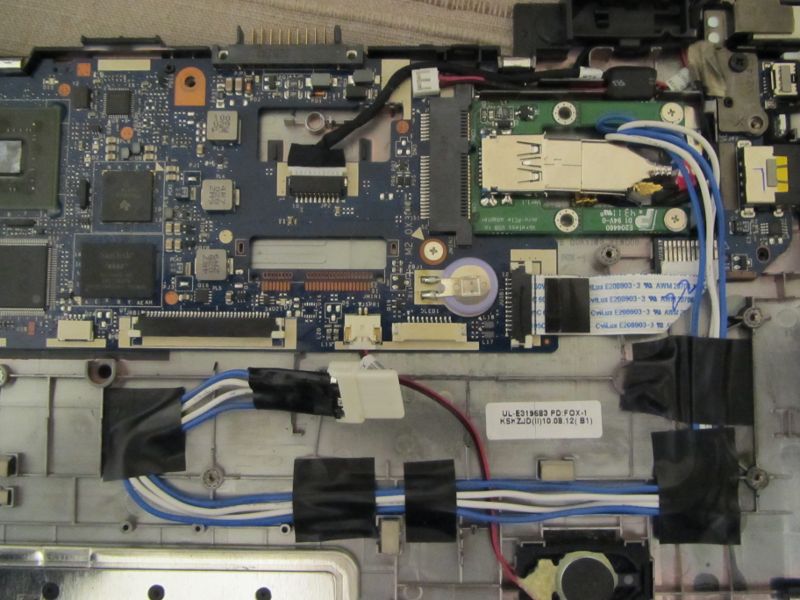
This is what it looks like with the top panel fitted. Note the large cut-out that has been made below the mini-PCIe slot access hole.
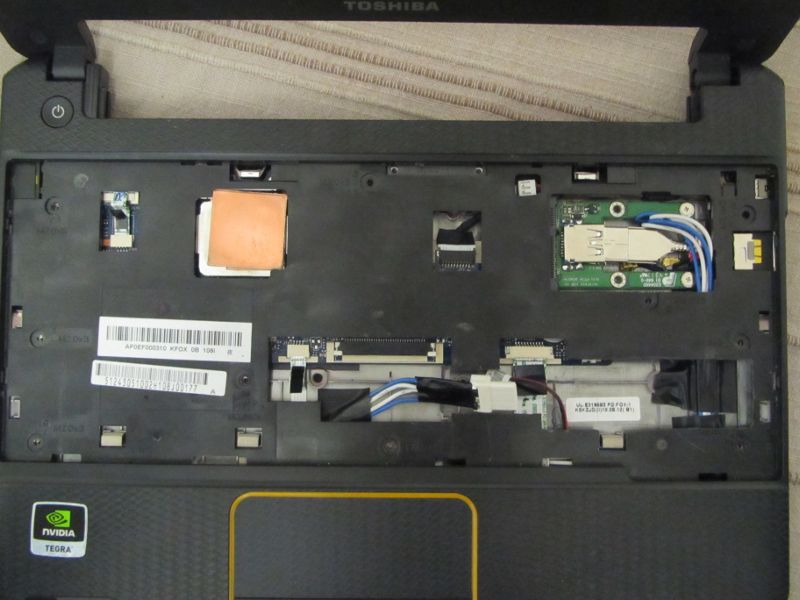
And again with the screws fitted. Note that one of the screw holes is in the area that had to be cut out. This shouldn’t affect the structural integrity of the AC100, though. Also note that the right speaker cable has been re-routed slightly to now go over the LED ribbon cable.
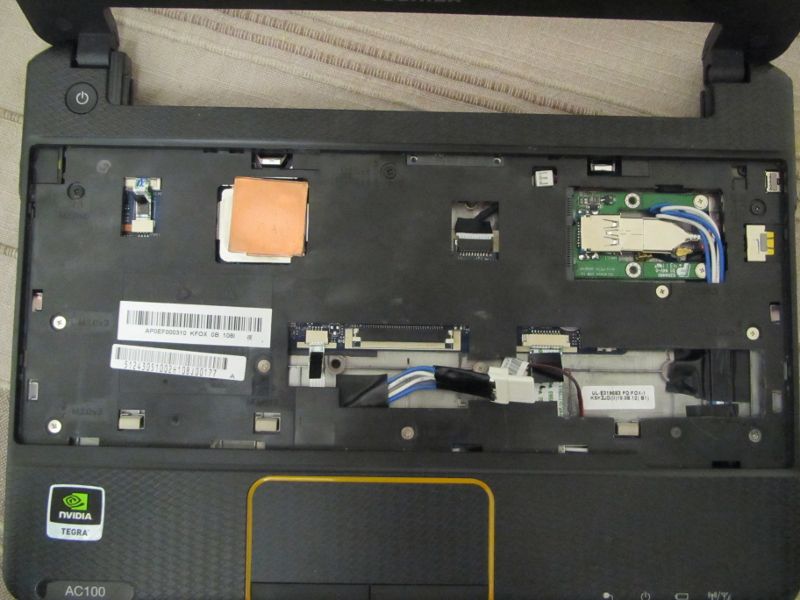
This is what it looks like with the RC8 attached. Now you can see why the cut-out in the top panel was exactly the shape it was – I specifically cut out the minimum possible amount to allow the RC8 to fit.
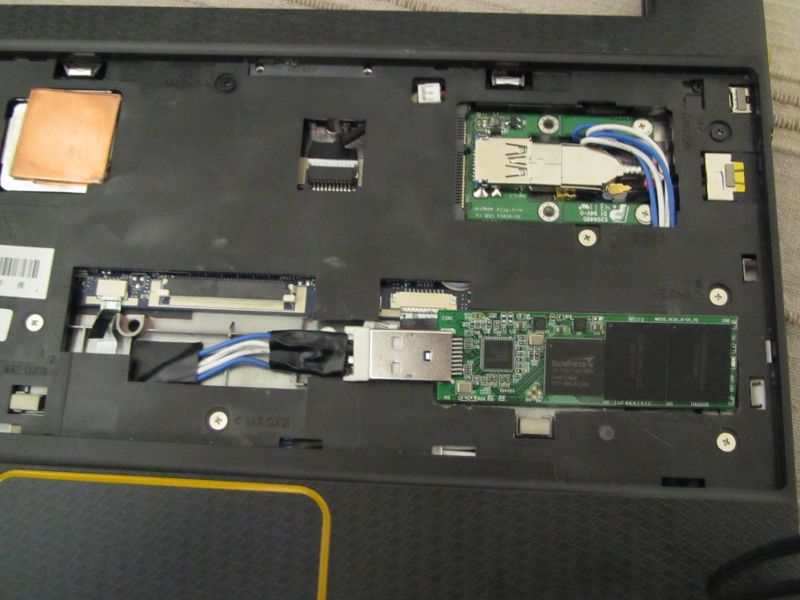
I also put a piece of thin transparent sticky tape over it to hold in in place, just to make sure nothing can short out against the underside of the keyboard.
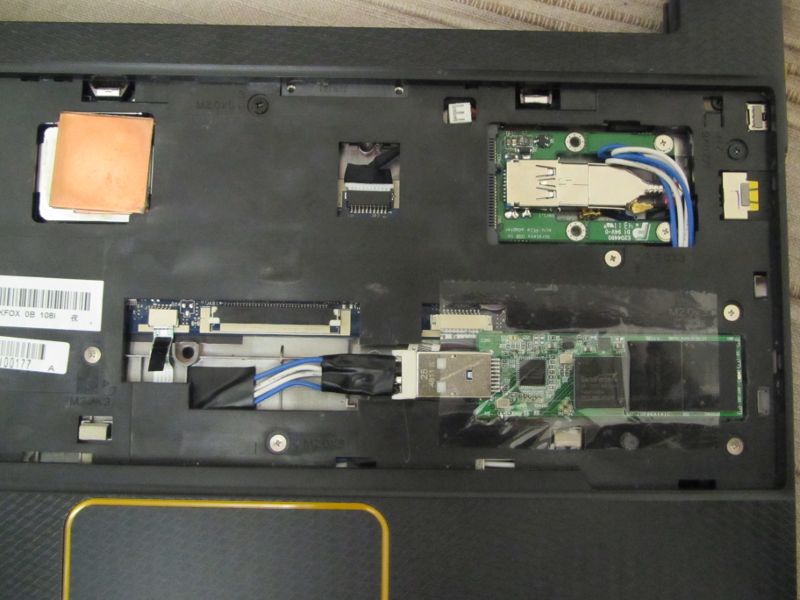
And that is pretty much it. Put the keyboard back in and bolt it all together. The metal part of the USB connector will sit a tiny bit above the line of the panel, but the only way you’ll notice it once you put the keyboard back on is by knowing that there is a tiny bulge there.
Your AC100 should now be able to handle ~ 2000 IOPS on both random reads and random writes, along with much better life expectancy that having proper flash management brings.
At this point I would like to point out just how impressed I am with the SuperTalent RC8 USB SSD. Not only is the performance fenomenal (for a USB stick at least), but it really behaves like a SATA SSD – to the point where you can use tools like hdparm and smartctl on it (yes, it even supports SMART).

Sweet! 😀
Now is there any place left inside that could be used to hold a tiny USB hub and a 3G modem? xD I have to admit – the integrated modem is the killer feature of the AC100 for me :P.
And couldn’t you just cut out the top metal part of the USB slot? It’s not like it’s needed to hold the plug in :P.
I very much doubt you could squeeze enough space somewhere to put a USB hub. The problem is that the USB connectors, especially the female end, are big. In the photos above, you’ll see that I actually removed the metal casing on the cable where the RC8 is connected – it’s the only way it can fit.
I don’t really see the integrated modem as that big a deal – most custom Android firmwares support tethering.
Well, I don’t own a smartphone, and don’t plan buying one. I’m almost happy with my 6-years old el-cheapo phone (Nokia FTW!) – except that it has too many features that clutter the interface. I wish someone did a phone that does nothing except calls, texts, and alarm clock. With a decent screen that can hold an entire SMS with a small font.
Well, enough of the off-topic :D. I hope you now understand my stand on the modem.
Yes, fair enough. In that case you could solder the USB cable that goes to the RC8 directly to the second mini-PCIe header.
Is that second header-to-nowhere wired-up the same way as the first one (i.e. only USB)? Have you tried if it works correctly?
I haven’t tried it, but I think it is wired up the same way as the other one.
Screw connectors! Remove ’em and solder the cables directly to the hub PCB. It’s not like you would disconnect them again, the hub was supposed to become a part of the smartbook.
But if the second PCIe header really has the USB lines wired as you said, all this is obviously not needed.
And you could do a few benchmarks to check if zram is still worth the hassle. I can imagine with that kind of IOPS it could be faster to just swap directly to the SSD…
It probably is, but it means needlessly wearing out the flash.
Then again, the 25GB RC8 actually has 32GB of flash on it – it is over-provisioned by 7GB, to enable some seriously advanced wear leveling and defect management. So in fairness, the chances of actually wearing out this SSD in any kind of sane use any time soon are pretty remote.
They’re even more remote if you shell out on a larger disk. The nice thing with SSDs is that the endurance is proportional to capacity!
Then again, the 100GB SuperTalent costs over twice as much as the AC100 itself. LOL.
It’s not just about size – it’s also about over-provisioning. With 7GB of space to play with on a 25GB disk (or 28 on a 100GB disk), you can do a LOT of clever flash management behind the scenes, that gets the write amplifications down to 1, or even lower if your controller also happens to do compression and deduplication (which the SandForce controller is rumoured to be doing).
I never claimed it’s not. This doesn’t change the fact that with a fixed amount of write cycles per block, a drive with twice the number of blocks will survive twice the total number of writes, ceteris paribus. At least with really good wear leveling.
That said, 28% of over-provisioning is really impressive. With all the good things you hear about SandForce, any of those drives is probably going to survive a long time used as a swap drive.
And if it doesn’t, at least you don’t have to solder anything to replace it with a new one ;-).